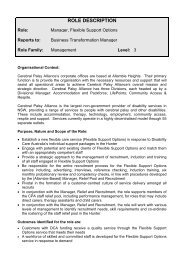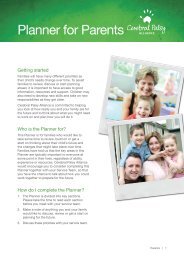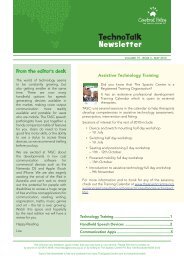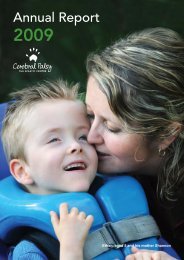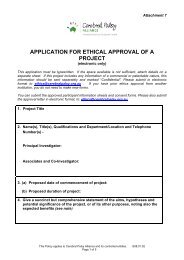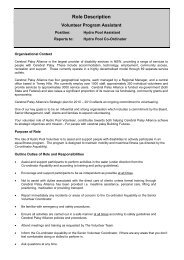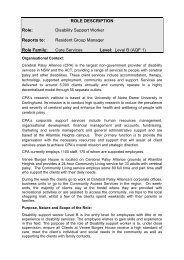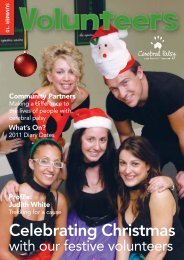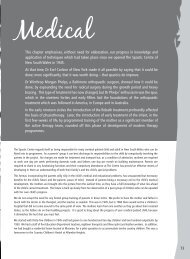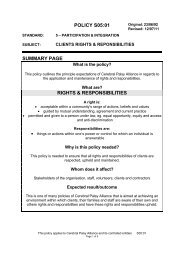Powered Mobility Manual - Cerebral Palsy Alliance
Powered Mobility Manual - Cerebral Palsy Alliance
Powered Mobility Manual - Cerebral Palsy Alliance
- No tags were found...
Create successful ePaper yourself
Turn your PDF publications into a flip-book with our unique Google optimized e-Paper software.
SKILL DEVELOPMENT AND SUPERVISION | 88.4 List of Potential ActivitiesActivities for use during the skill development phase of powered mobility intervention are unlimited. Currentevidence recommends that activities should be chosen to promote an individual’s participation in everydayactivities and routines (Campbell, Milbourne, Dugan and Wilcox, 2006). Activities should be relevant toindividual interests and should be age appropriate. With children, activities need to involve play and fun, aslearning is known to occur through play.Applying the Janeschild (1997) stage progressions, it would be appropriate to place sensory, play andfun focused activities into stage one. Stage two would naturally include the activities that would provideopportunity to develop and refine directional skills. Stage three could still include fun activities but the focuswould shift to purposeful or functional activities as relevant to users developing independence.The following activity ideas have been grouped as examples for your interest. Each activity should beadapted to meet the needs, skills, age, interests and relevance to the individual.Stage One: Exploratory stage• Set up the room with sensory props such as: hanging streamers, fabrics or balloons to move through,bubble wrap or squeaky toys to run over, macaroni or dry leaves to crunch, bubbles to follow, cardboardboxes to move around or stack.• Boxes can be stacked and knocked down for an age appropriate fun activity like blocks/boxes are used forsmall children. NOTE: only use in the early phase, so as not to reinforce the idea of using a PWC as adevice to run objects down.• Play cross the pond, use a tarp to run over, add fish.• Build a tall posting box to post letter/balls.• Use a large ball or two to bump, push or follow around the room. This can be turned into a game, like soccer.• Play follow-the-leader, and take turns being leader.• Use music to play musical stop-and-go games, e.g. musical statues.• Place snacks or drinks on a table in view. If user moves to that area, offer them a snack or drink.Stage Two: Directive stage• Place items around the room that will be motivating to move towards, e.g. posters of movie stars, sportstars. Include interesting items or details to examine at each station.• Collect items from a shopping list, place them around the room to be located.• Design a treasure hunt with clues to move from one to the next, finish with a prize.• Use letters or numbers on the floor to spell or answer maths questions.• Place obstacles to move around, chalk lines to follow, coloured dots to move to.• Play a simple board game on the floor. Use chalk, coloured paper, dice, etc.• Suspend hats from the ceiling around the room. Move under hat to select, try on, assume characters.• Try a magnetic fishing set, move around the pond (tarp) or onto lily pads (cardboard) to reach fish with line.Stage Three: Purposeful stage• Go to places of interest and explore, e.g. garden/park• Go and turn on TV/radio.• Encourage user to identify and locate places of interest to them.• Explore a variety of terrain, e.g. pathways, slopes, gravel, ramps.• Daily activities: collecting the mail, choosing plate/cup/utensils for meals, putting dirty laundry in thebasket, carrying shopping items, using a lift, positioning self by basin to brush teeth.• Visit community places. Grade the level of difficulty as skills develop. Begin with quiet, non-crowded placesand choose the time of day carefully. Suggestions: visit a museum, library, mall, movie theatre, social group.56




